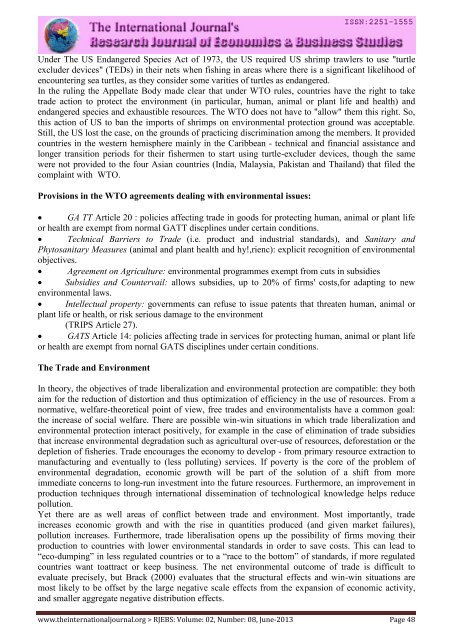Research Journal of Economics & Business Studies - RJEBS - The ...
Research Journal of Economics & Business Studies - RJEBS - The ...
Research Journal of Economics & Business Studies - RJEBS - The ...
- No tags were found...
You also want an ePaper? Increase the reach of your titles
YUMPU automatically turns print PDFs into web optimized ePapers that Google loves.
Under <strong>The</strong> US Endangered Species Act <strong>of</strong> 1973, the US required US shrimp trawlers to use "turtle<br />
excluder devices" (TEDs) in their nets when fishing in areas where there is a significant likelihood <strong>of</strong><br />
encountering sea turtles, as they consider some varities <strong>of</strong> turtles as endangered.<br />
In the ruling the Appellate Body made clear that under WTO rules, countries have the right to take<br />
trade action to protect the environment (in particular, human, animal or plant life and health) and<br />
endangered species and exhaustible resources. <strong>The</strong> WTO does not have to "allow" them this right. So,<br />
this action <strong>of</strong> US to ban the imports <strong>of</strong> shrimps on environmental protection ground was acceptable.<br />
Still, the US lost the case, on the grounds <strong>of</strong> practicing discrimination among the members. It provided<br />
countries in the western hemisphere mainly in the Caribbean - technical and financial assistance and<br />
longer transition periods for their fishermen to start using turtle-excluder devices, though the same<br />
were not provided to the four Asian countries (India, Malaysia, Pakistan and Thailand) that filed the<br />
complaint with WTO.<br />
Provisions in the WTO agreements dealing with environmental issues:<br />
GA TT Article 20 : policies affecting trade in goods for protecting human, animal or plant life<br />
or health are exempt from normal GATT discplines under certain conditions.<br />
Technical Barriers to Trade (i.e. product and industrial standards), and Sanitary and<br />
Phytosanitary Measures (animal and plant health and hy!,rienc): explicit recognition <strong>of</strong> environmental<br />
objectives.<br />
Agreement on Agriculture: environmental programmes exempt from cuts in subsidies<br />
Subsidies and Countervail: allows subsidies, up to 20% <strong>of</strong> firms' costs,for adapting to new<br />
environmental laws.<br />
Intellectual property: governments can refuse to issue patents that threaten human, animal or<br />
plant life or health, or risk serious damage to the environment<br />
(TRIPS Article 27).<br />
GATS Article 14: policies affecting trade in services for protecting human, animal or plant life<br />
or health are exempt from nornal GATS disciplines under certain conditions.<br />
<strong>The</strong> Trade and Environment<br />
In theory, the objectives <strong>of</strong> trade liberalization and environmental protection are compatible: they both<br />
aim for the reduction <strong>of</strong> distortion and thus optimization <strong>of</strong> efficiency in the use <strong>of</strong> resources. From a<br />
normative, welfare-theoretical point <strong>of</strong> view, free trades and environmentalists have a common goal:<br />
the increase <strong>of</strong> social welfare. <strong>The</strong>re are possible win-win situations in which trade liberalization and<br />
environmental protection interact positively, for example in the case <strong>of</strong> elimination <strong>of</strong> trade subsidies<br />
that increase environmental degradation such as agricultural over-use <strong>of</strong> resources, deforestation or the<br />
depletion <strong>of</strong> fisheries. Trade encourages the economy to develop - from primary resource extraction to<br />
manufacturing and eventually to (less polluting) services. If poverty is the core <strong>of</strong> the problem <strong>of</strong><br />
environmental degradation, economic growth will be part <strong>of</strong> the solution <strong>of</strong> a shift from more<br />
immediate concerns to long-run investment into the future resources. Furthermore, an improvement in<br />
production techniques through international dissemination <strong>of</strong> technological knowledge helps reduce<br />
pollution.<br />
Yet there are as well areas <strong>of</strong> conflict between trade and environment. Most importantly, trade<br />
increases economic growth and with the rise in quantities produced (and given market failures),<br />
pollution increases. Furthermore, trade liberalisation opens up the possibility <strong>of</strong> firms moving their<br />
production to countries with lower environmental standards in order to save costs. This can lead to<br />
“eco-dumping” in less regulated countries or to a “race to the bottom” <strong>of</strong> standards, if more regulated<br />
countries want toattract or keep business. <strong>The</strong> net environmental outcome <strong>of</strong> trade is difficult to<br />
evaluate precisely, but Brack (2000) evaluates that the structural effects and win-win situations are<br />
most likely to be <strong>of</strong>fset by the large negative scale effects from the expansion <strong>of</strong> economic activity,<br />
and smaller aggregate negative distribution effects.<br />
www.theinternationaljournal.org > <strong>RJEBS</strong>: Volume: 02, Number: 08, June-2013 Page 48

















